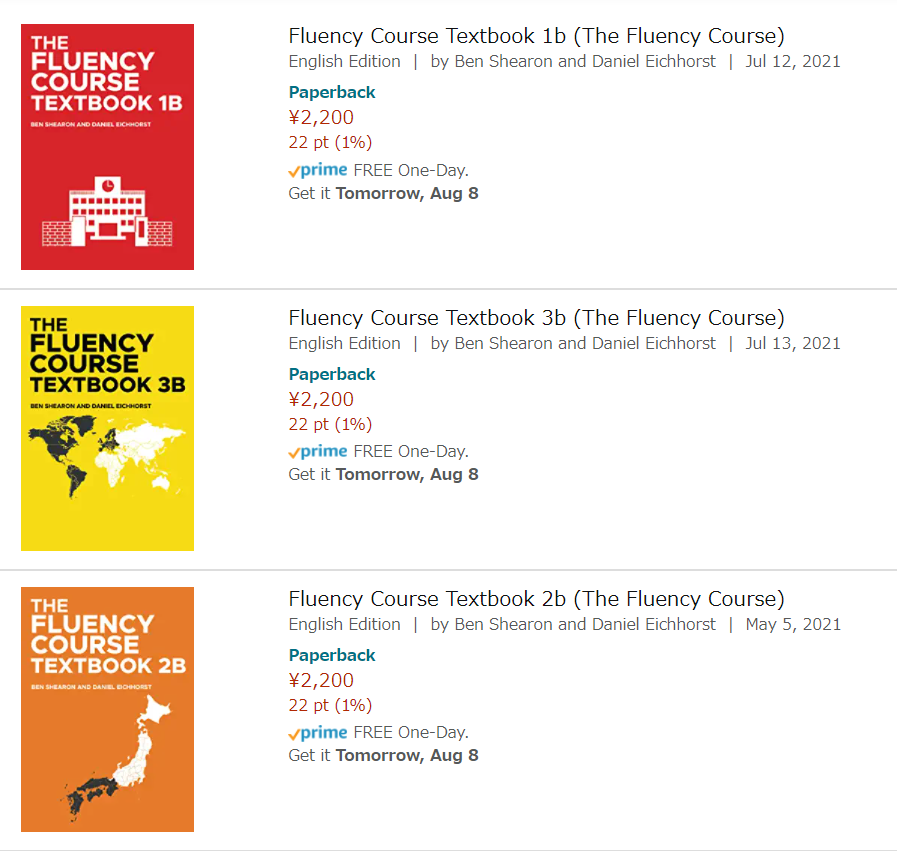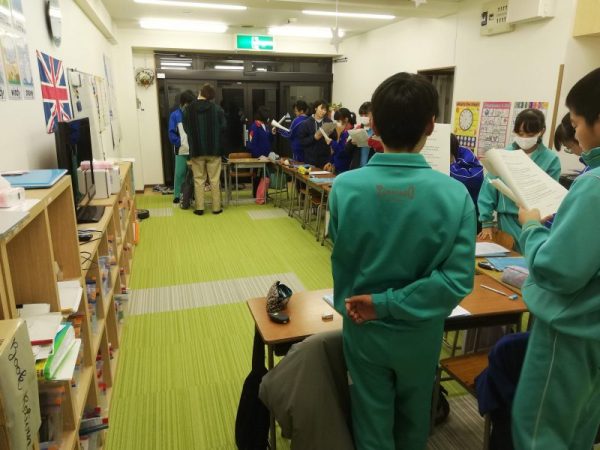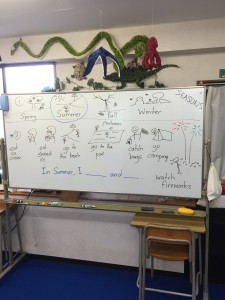Four Day Teaching Week

I’ve been helping my wife to run her school, Cambridge English in Sendai, for almost twenty years now. One of our main goals is to make it the best working environment possible.
A couple of years ago I had an idea: what if we could cut the teaching week to four days? Our school needs three full time teachers to teach all the classes, but that means that if someone is sick or wants to take a day off we have a problem.
And that is not fair to the teachers. They shouldn’t feel pressured to work just because we don’t have any slack in the system. But that is how things are at many small eikaiwas.
If we could just hire a fourth teacher, we would have someone to cover. It would also allow us to cut the regular teaching load from 26-7 classes a week to 20.
Each teacher would teach three weekdays and Saturday, and have one day to prep, work on projects, or cover for someone else if they couldn’t be there that day. Teachers who proved they were able to work independently could work from home on their non-teaching day.
It seems like a win-win. The teachers will be more relaxed and have time to work on our curriculum and materials and the school will become more robust.
We are not planning to reduce salaries due to this change, so our school should become a more attractive place to work, which should allow us to keep teachers for longer and have more applicants to choose from when we do need to hire someone.
Is anyone else doing a four-day teaching week or considering one?
Academy curriculum EFL eikaiwa JHS junior high school language courses materials publishing textbooks
by sendaiben
leave a comment
The Fluency Course 2022
Is finally available on Amazon

I can’t believe this day is finally here. After six(?) years of writing, testing, re-writing, and figuring out how to publish and sell it without driving ourselves and our staff crazy, the B versions of all our textbooks are now available on Amazon in their final form.
Incredibly, we’ve made a lot of improvements to this latest (final?) version. We added a dictation activity to the first year books, made a simple change to the second year writing practice that should make a big difference to student results, and transformed the third year textbook.
I think our current users are going to be very pleasantly surprised, and new ones will just think the books were this good from the beginning 😉
We use the B books from October with our students, so we’ll have all the free supplementary stuff up on the Fluency Course website before then.
We’re also hoping to have the final versions of the A books up on Amazon/our site by the end of the summer, at which point I’m going to take my writing partner for a nice meal and we’re going to take a week or so off.
Would be really grateful for any help you could give us with promoting the course, telling people about it, leaving Amazon reviews, etc.
Please let me know if you have any questions! For people buying the course for their students, I would be happy to jump on a Zoom call to answer your questions or run you through how we use the books.
Academy business curriculum eikaiwa extensive listening extensive reading goals high school JHS junior high school language courses materials school management textbooks
by sendaiben
1 comment
Cambridge Academy: Year Four and Five

It’s all coming together. Or is it?
You can read previous Academy posts here:
- Extensive Reading for Secondary Students (April 2015)
- Six Months In (September 2015)
- Year One (February 2016)
- Looking at Year Two (March 2016)
- Stocktake (March 2016)
- Shadoku explained (April 2016)
- Some improvements to the curriculum (April 2016)
- December 2016 update (December 2016)
- Cambridge Academy: Year Two and Three (March 2017)
- Cambridge Academy: Stocktake 2017 (March 2017)
- Cambridge Academy: Another Quantum Leap (April 2017)
- Cambridge Academy: Year Three Mid-Year Update (August 2017)
- Cambridge Academy: Year Three Student Progress (October 2017)
- The Academy Fluency Course (March 2018)
- Cambridge Academy: Stocktake 2018 (March 2018)
This year was a solid one for the Academy but we definitely had some ups and downs.
Mistakes were made (by me)
Let’s start with the downs: we screwed up badly not just once but twice. The first mistake was getting a bit cocky about the Academy and changing the way we explained it to existing students.
In the past we’d gone into each class with 6th graders in, introduced the Academy and encouraged them to join. Almost everyone did.
Last year, we asked everyone to come to a special explanation session on a Sunday, then asked them to come in again in January and line up to sign up for the days they wanted. Only about half the students joined.
This is a mistake we’ll be paying for for the next five years, as we have a year that is quite a bit smaller than it should be. Looks like we’ll have 22 second-year students next year, spread over three classes of 4, 6, and 12 students. Doubly regrettable because the Academy classes work much better with at least ten students in.
This year we went back to the original, more humble model and right now halfway through the explanations pretty much all our 6th graders have signed up. If all goes well we should end up with 28 first-graders in three classes.
The second mistake was delegating too much. As planned I assigned a teacher to each class, but then failed to monitor them as closely as I should have (in my defence we had some pretty serious issues crop up this year that took a lot of time at first and then burned me out later).
As a direct consequence of me not paying enough attention to how the classes were going, the current first-year classes in particular are not where I want them to be, and all the reading classes have gone slightly off course.
Nothing too serious, but changes will be needed next year.
But lots of good things happened too
Despite the lack of attention from me, the classes mostly went well and students learned a lot. We did Eiken last month at the school, and 78 out of 82 students passed the paper test. Last weekend we did interview practice, and everyone was basically okay to pass. This is very encouraging, as our student body is very mixed and doesn’t just consist of elite students.
We wrote 2/3 of the A3 output course, and it turned out really well. I’m proud of all our materials, but this might be the best one yet. We also finished one year of the A5 advanced course.
Very few of our students quit. We lost a handful to graduation and three quit, but we’re hoping to have a healthy intake and we also had four students join from outside. Hopefully that is the start of a trend 🙂
Student numbers
Junior high school 1: 28? (still in the process of pitching to parents)
Junior high school 2: 22
Junior high school 3: 30
Senior high school entry class (1-2 year students): 10
Senior high school advanced class (2-3 year students): 11
Pretty encouraging. It will be interesting to see how many of the new JHS 3rd years stay on into high school, as they were our first big year.
Also, the mathematically gifted among you will notice that this would give us 101 students, finally reaching our longstanding goal of 100 students in the Academy. Eventually I am hoping we’ll have something like 200 in the program (see below for how this may be possible).
Future plans
We’re going to rent the third unit on the ground floor of our building. This will give us all the car parking spaces (an additional four) plus get rid of the grumpy guy that used to rent it so no one will be complaining about our students going forwards. This extra unit will give us about 280 new class places and allow us to have all junior high school levels of the Academy, plus one high school level, every weekday.
I’m going to be much more hands on with the reading classes next year, and with the junior high school first year output classes. This will allow me to develop them a bit more and address structural problems (as well as train our teachers).
I’m going to take another leaf out of SEG’s book and try to find supplementary reading material for our beginner levels. At the moment the students read sets of readers with CDs, but I would also like to mix in picture books and other reading material that they might find interesting. A big work in progress.
We’ll finish the A3 course and start working on our final level, A4. We’ll also write a second year of the A5 course. This will complete the Academy materials, at which point we might start working on a course for elementary school students.
Outlook
The outlook is good. I am not going to be able to be as hands-off next year as I was this year, but I think the program will get a lot stronger because of that.
We will be in a position to recruit hundreds of new students next year, including almost 100 new Academy students, so we will need to start working on advertising for April 2020 from now. It’s going to be intense but also kind of fun 🙂
Selling a Language School in Japan
But what’s it worth?
Many people in Japan think about opening their own English school. Some people actually do so. But what is the end game? What happens when you no longer want to operate your school?
One option is to sell it.
There are many things to consider when selling a school. I’ve been doing a bit of research on this recently, and it’s been interesting and a bit discouraging 🙂
Valuation
This is probably the hardest aspect of the whole thing. There is no easy way to decide how much a business is worth. Ultimately it comes down to how much someone is willing to pay for it, and whether the owner decides to accept that price.
Some metrics I have heard about are a price per current student, or a multiple of net annual profit (2-5 times seems possible).
Whether the school is a company or just privately run by an individual would appear to make a difference (it’s more valuable as a stand-along company).
Having the owners involved in teaching or admin roles makes the school less attractive, as the students may be there because of the personal connection and may leave when the owners do.
Any assets held by the school may be added to the purchase price, but most teaching materials or furniture probably aren’t worth very much second-hand.
Taxation
Now even if you manage to sell your school for an acceptable price, the government is going to want its share of the proceeds.
There appear to be two possibilities here. If the school is incorporated and was bought then capital gains tax might be payable.
If the school was privately held then income tax would be payable. Looking at national income tax, the brackets seem to be:
-under 1,950,000 yen 5%
1,950,000-3,300,000 yen 10%
3,300,000-6,950,000 yen 20%
6,950,000-9,000,000 yen 23%
9,000,000-18,000,000 yen 33%
18,000,000-40,000,000 yen 40%
Over 40,000,000 yen 45%
You would also have to add inhabitants tax of around 10%.
What this means for us
Well, my wife runs a small English school. We are considering a number of options for when we are no longer willing or able to run it, including selling or giving it to a family or staff member, selling it to a third party, or closing it down (and donating resources to local schools or organizations).
My research indicates that most schools seem to be bought and sold as fire, or forced, sales, when an owner needs to sell quickly as they are leaving the country. This results in low prices paid for schools.
For us, selling for three times net annual income doesn’t sound like a great deal, particularly if we do the work to make the school run without our day-to-day input. Once you consider the impact of taxes on the sale price, we’d be better off running it for another couple of years and would be able to save more than we would get in a sale price.
It’s not even much of a jump from a hands-off business to one that you could monitor remotely.
I guess if we ever reached the point where we didn’t want anything to do with the school I guess we could sell, but even in that situation I think I would rather sell to an owner operator and amortize the purchase price over a number of years, possibly by securing an advisory role. This would probably reduce taxes and increase the eventual gain from the sale.
Anyone have any advice/experience on this topic? Am I completely wrong on anything?
Edit: Steven N. posted this great article by Dean Rogers (who is a really approachable and helpful person) on the Facebook page. Well worth a look.
Freestyle warmups for children’s classes
Recently I have been doing these kinds of freestyle warmups with children’s classes. They are easy, fun, interactive, and break up a regular class well.
Start by introducing the language on the board. Then practice orally. Finally have students write their personalized version in their notebooks. The whole thing takes about ten minutes.

